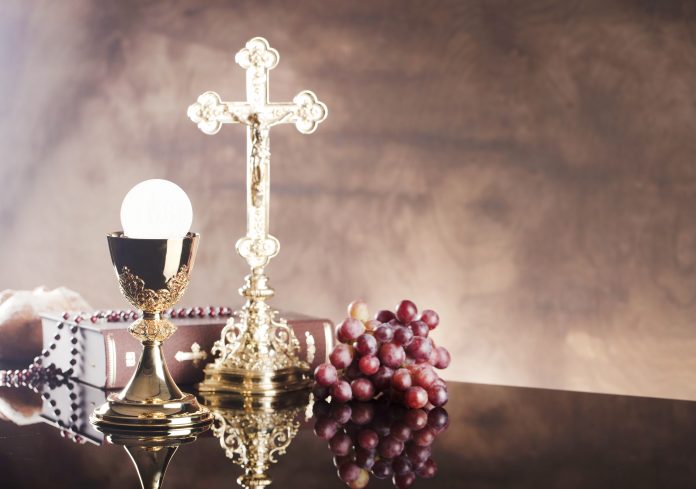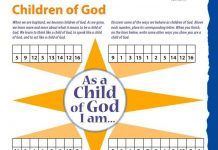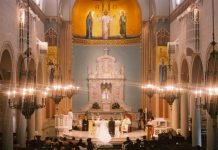
by Kate Ristow
For an activity that will help students understand the interrelationship between friendship and choosing a marriage partner, see the end of this article.
By nature, we are a hopeful people. In spite of the fact that statistics consistently reveal that 50% of first marriages end in divorce, the Official Catholic Directory reports that 191,200 couples in the United States celebrated the Sacrament of Matrimony in the Church in 2009.
Perhaps our hopefulness is rooted in God’s pronouncement in the Garden of Eden: “It is not good for the man to be alone. I will make a suitable partner for him” (Genesis 2:18). Scripture then tells us that the woman God created was such a suitable partner for the man that—then and now—this is “why a man leaves his father and mother and clings to his wife, and the two of them become one body” (Genesis 2:24).
Teaching about Matrimony: The Challenge
Teaching about Matrimony, one of the two Sacraments at the Service of Communion, can be a challenging undertaking. On the one hand, we need to help our students understand fully what the Church teaches about Christian Marriage. On the other hand, we want to be sensitive to the feelings of any students whose parents are separated, divorced, or deceased.
However, we cannot let our desire to be compassionate prevent us from emphasizing the fact that, for Catholics, marriage is a permanent and lifelong commitment. Skipping over this important belief undercuts the very reason Matrimony is a Sacrament—one of the seven sacred signs of God’s love and Jesus’ presence among us. As catechists, we must never be afraid to proclaim the truth with love.
Considering God’s Call to Us
Begin by reminding the kids that God has a plan for each of us. Divide the class into two teams and announce that you are going to play “Wheel of Fortune” to discover the name we give to God’s call to each of us. Draw eight blanks in a vertical line across the board or on a poster. Have teams alternate turns guessing letters until they identify the word vocation.
Help students remember that we receive a special call—or vocation—to serve God, the Church, and others in the Sacrament of Baptism, when we begin to share in the priesthood of Christ. Emphasize that no matter what career we choose—web designer, veterinarian, teacher, accountant, etc.—God calls us to live our faith every day and to be signs of God’s kingdom in the world and for the people in our lives.
Some people choose to live out their vocations as single people; others choose to live their vocations by becoming priests, vowed religious, or married people. Point out that each of these vocations is a path to holiness.
Invite the class to brainstorm how being married can be a path to holiness for the married partners and how a couple’s relationship can be a sign of God’s kingdom of love, peace, and justice for others. Ask two students to record on the board the ideas that are generated. Point out that married couples live their lives together, sharing—as the vows they make on their wedding day proclaim—faithfulness, good and bad times, sickness and health. They promise to love and honor each other all the days of their lives.
Ask students to form small groups to share stories of married couples they admire and to name one specific way the people they name provide examples of married love. After allowing 10 to 15 minutes for discussion, call the class back together. Invite each group to sum up the characteristics of the couples they identified.
Emphasize that marriage is not easy and that people who have “happy” marriages are not just lucky. Help kids appreciate that marriage takes work and that both people need to be willing to change and grow. The man and the woman have to forgive each other and find ways to spend time together—to talk, laugh, and share their lives.
Exploring the Rite
Take time to go through the Rite of Matrimony with the class. Emphasize the following points:
* Marriage ordinarily is celebrated at a special Mass.
* In the Sacrament of Matrimony, the bride and the groom are the celebrants; the priest or deacon is the Church’s official witness of the Sacrament.
* After the homily, the couple answers three important questions: Are they free to give themselves to each other in marriage? Will they love and honor each other as husband and wife for the rest of their lives? Will they accept children lovingly and bring them up according to the law of Christ and his Church?
* Then the couple pledges their love for each other by stating vows. Rings are blessed and then exchanged as a sign of the couple’s love and fidelity, or faithfulness.
* The Mass then continues. After the Lord’s Prayer, the couple receives the nuptial blessing. In this special prayer, the priest asks God to give the couple the graces they will need to love each other, to be living examples of the Christian life, and to help them to be good parents.
The Covenant and the Mirror
The meaning of Christian Marriage is found first in the covenant between God and the Israelites in the Old Testament. God promised that the Israelites would be his special people and that he would love and care for them. In turn, the Israelites promised that they would faithfully obey God.
Explain to the class that marriage is a covenant. The couple promises to take care of each other and the children with which they are blessed. They also promise to be faithful to each other.
Remind students that the covenant God made with the Israelites prepared the way for the new and perfect covenant made possible through the life, death, Resurrection, and Ascension of Jesus. Christian Marriage is meant to be a mirror—a reflection of the love of Jesus for his Church. Jesus loves us and is with us always—through the Sacraments and the Holy Spirit. We, the Body of Christ, promise to love Christ and one another, and to be faithful to his teachings and to the teachings of the Church.
The love of a husband and a wife is a sign of Christ’s love for his Church. Just as Jesus’ love for us is never-ending, the love of a husband and wife is also meant to be permanent.
As you make these important points with the students, help them appreciate that God understands that people are human and that couples sometimes experience such great difficulties in marriage that they are unable to stay together even with the help of prayer, the Sacraments, and counseling.
Emphasize that it is not our place to judge others. A couple’s problems are private. Remind the class that God continues to love each family member affected by separation or divorce. Encourage students who are struggling with a difficult family situation to ask for help. Take time on a regular basis to pray for families who are estranged, without being specific.
Celebrate Matrimony with Activities
* Arrange for a panel discussion on marriage for your junior high students. Invite three couples in different stages of marriage to participate on the panel: newlyweds, a couple with several school-aged kids, and a couple in their senior years. Ask each couple to prepare a three-minute talk on the joys and challenges of marriage. Then invite questions. If you choose your couples wisely, this activity is sure to be a hit with your class!
* Provide art materials for each student to make a greeting card for a couple they think of as a great example of married love—their parents or grandparents, an aunt and uncle, a couple from the neighborhood, or the parents of a close friend. After their cards are decorated, encourage students to write in each a brief note expressing why they admire the couple’s relationship.
* Invite a member of your Marriage Preparation Team to visit your class to talk about how the team works with couples preparing to celebrate their weddings in your parish. How many meetings do engaged couples attend? What happens at the meetings? If a Pre-Cana retreat is part of the process, invite your guest speaker to explain what couples experience at the weekend.
* Divide the class into small groups of four or five students each. Have each group create a poster honoring the married couples in your parish. Hang the posters in public areas of the parish.
* Read 1 Corinthians 13:4-8 aloud to the class. Then challenge students to write a modern version of St. Paul’s “Love is…” advice, not just for married couples but for all Christians. After students share their ideas with the class, have them make a montage of the qualities they name. Decorate the montage with photographs of couples at different stages of life.
* Invite students to do internet searches and prepare reports on married individuals or couples who have been beatified or canonized as saints. Provide them with a list of names to research, including: St. Margaret of Scotland and King Malcolm; St. Isidore the Farmer and St. Maria de la Cabeza; St. Gianna Beretta Molla and Pietro Molla; Blessed Louis and Blessed Zelie Martin; and Blessed Luigi Quattrocchi and Blessed Maria Corsini. Ask students to focus their reports on how couples lived out their vocations to serve God and others.
Analyzing the Scripture Readings
Prior to class, print the Scripture references listed below on the board or a poster. Explain that these are the readings from which engaged couples may choose for Mass on their wedding day.
Divide the class into three groups and assign one set of readings to each group. Have the kids look up and read the Scriptures and decide—as a group—which reading they find most appropriate for a wedding Mass. Ask each group to explain to the class the reason for its choice.
First Reading (Old Testament)
Genesis 1:26-28, 31
Genesis 2:18-24
Genesis 24: 48-51, 58-67
Tobit 7:9-10, 11-15
Tobit 8:5-10
Song of Songs 2:8-10, 14, 16; 8:6-7
Ecclesiasticus 26:1-4, 16-21
Jeremiah 31:31-32, 33-34
Second Reading (New Testament)
Romans 8:31-35, 37-39
Romans 12:1-2, 9-18
1 Corinthians 6:13-15, 17-20
1 Corinthians 12:31; 13:8
Ephesians 5:2, 21-33
Colossians 3:12-17
1 Peter 3:1-9
1 John 3:18-24
1 John 4:7-12
Revelation 19:1, 5-9
The Gospel Reading
Matthew 5:1-12
Matthew 5:13-16
Matthew 7:21, 24-29
Matthew 19:3-6
Mathew 22:35-40
Mark 10:6-9
John 2:1-11
John 15:9-12
John 15:12-16
John 17:20-26
Kate Ristow, Contributing Editor to CATECHIST, is National Catechetical Consultant for RCL Benziger. She has been involved in children’s religious education for over 25 years as a Catholic-school teacher and parish catechist.
Friendship and Marriage
Use this Friendship Forever worksheet [CLICK HERE] to help students understand the interrelationship between friendship and marriage. Have students work in pairs to complete the worksheet. Close your class discussion with a prayer for all those preparing for marriage, for all those who are married, and for all families.
Copyright 2010, Bayard, Inc. All rights reserved. This article is protected by United States copyright and other intellectual property laws and may not be reproduced, rewritten, distributed, redisseminated, transmitted, displayed, published or broadcast, directly or indirectly, in any medium without the prior written permission of Bayard, Inc.
This article was written by the Catechist Staff and appeared in Catechist magazine, December 2010.
Image Credit: Zolnierek/Shutter Stock 592148795




